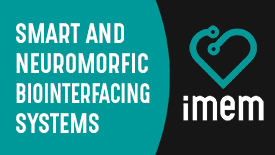The activity is based on a new element, Organic Memristive Device (OMD), that mimics several important properties of natural synapses. In particular, it was used as key element for the artificial implementation of bio-inspired circuits and systems, allowing associative learning at the hardware level; for the realization of single and double layer perceptrons; first steps towards the synapse prosthesis; realization of self-assembled networks with stochastic architecture and very large integration level, allowing memorizing and processing of the information.
An important difference in the architecture of computers and brain is that in the first case memory and processor are represented by separate devices with no influence one on the other, while in the brain same elements are used for both memorizing and processing of the information. Such architecture allows several important features, such as learning at the hardware level (the information is not only memorized, but it changes connections inside the “processor”), parallel processing (in single nucleus computer only one operation is performed at each moment); low weight (due to 3D highly integrated organization) and high energy efficiency (due to simultaneous performing of multiple operations).
In this respect our group has a world-wide priority in the realization, study and applications of Organic Memristive Device an element that was designed for mimicking properties of natural synapses in electronic circuits and systems.

These elements were effectively used for the implementation of logic gates with memory, artificial neural networks (single and double layer perceptrons), neuromorphic applications (nervous system mimicking electronic circuits allowing supervised and unsupervised learning; frequency driven plasticity; first steps toward the synapse prosthesis), and complex 3D networks with very high degree of integration and stochastic organization of functional units.
It is to note that electrochromic properties of the used materials allow unique possibility of contactless control of the resistance state and kinetics of its variation of functional elements, that is extremely important in the case of training of artificial neuron networks with more than one layer architecture.
| - Combination of Organic-Based Reservoir Computing and Spiking Neuromorphic Systems for a Robust and Efficient Pattern Classification is online on Advanced Intelligent Systems |
| - A Ti‐Doped Chemical Vapor Deposition Diamond Device as Artificial Synapse for Neuromorphic Applications is published online on Advanced Materials Technologies! |
| ► Our publications and collaborations. |








